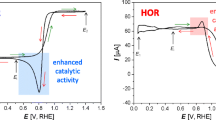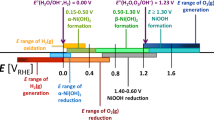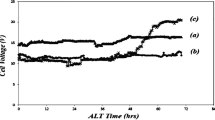Abstract
Research on the degradation of Pt materials is of high importance to the polymer electrolyte membrane fuel cells (PEMFCs) technology, since their degradation translates into irreversible materials loss and significant deterioration of the PEMFCs’ performance. Polycrystalline platinum (Pt(poly)) serves as a model system in research on Pt-based electrocatalysts for PEMFCs due to its randomly oriented grains separated by grain boundaries, and experimental studies using Pt(poly) create important background knowledge that may be used to identify and understand electrochemical and corrosion phenomena taking place in PEMFCs. In this contribution, we report new results on the corrosion behavior of Pt(poly) in 0.50 M aqueous H2SO4 solution saturated with a neutral (N2(g)) or reactive gas (O2(g) or H2(g)). We analyze the influence of the potential scan rate (s = 0.10, 0.20, 0.50, and 1.00 mV s−1) on the polarization behavior of Pt(poly) in anodic (positive-going) and cathodic (negative-going) directions. A comparative analysis of the impact of dissolved gases on the electrochemical and corrosion behavior of Pt(poly) is performed using cyclic voltammetry and potentiodynamic polarization. Their analysis reveals that the corrosion data obtained at the lowest potential scan rate (s = 0.10 mV s−1) are the most accurate and representative of the corrosion of Pt(poly) in 0.50 M aqueous H2SO4 solution. This is due to the fact that polarization measurements are designed to mimic steady-state conditions, which can only be achieved in the case of s = 0.10 mV s−1 or lower. A comparison of the corrosion data leads to the following observations: (i) Pt(poly) does not undergo corrosion in the electrolyte saturated with H2(g), (ii) it undergoes a slight corrosion in the electrolyte outgassed with N2(g), (iii) it undergoes a substantial corrosion in the electrolyte saturated with O2(g), and (iv) the corrosion rate is more significant in the case of the anodic transient than the cathodic ones (for the same dissolved gas).

The first ever study of Pt(poly) corrosion using potentiodynamic polarization. Anodic and cathodicpotentiodynamic polarization curves for Pt(poly) in 0.50 M aqueous H2SO4 solution saturated with N2(g), O2(g) or H2(g) acquired at a potential scan rate of s = 0.10 mV s-1 and T = 298 K.








Similar content being viewed by others
References
S. Litster, G. McLean, PEM fuel cell electrodes. J. Power Sources 130, 61 (2004)
D. Papageorgopoulos, Fuel Cells Overview. Presented at the U.S. Department of Energy (DOE) 2014 Fuel Cells Annual Merit Review, Washington DC, June 16–24, (2014) http://www.hydrogen.energy.gov/pdfs/review14/fc000_papageorgopoulos_2014_o.pdf. Accessed 1 Aug 2014
X.-Z. Yuan, H. Wang, in PEM Fuel Cell Fundamentals, ed. by J. Zhang, PEM Fuel Cell Electrocatalysts and Catalyst Layers: Fundamentals and Applications, (Springer-Verlag, London, 2008), p. 4–34.
F. Barbir, PEM Fuel Cells: Theory and Practice, 2nd edn. (Academic Press, Cambridge, 2013), pp. 2–16
A. Lasia, in Handbook of Fuel Cells, ed. by W. Vielstich, A. Lamm, H. A. Gasteiger, Fundamentals, Technology, Applications, vol 2 (Wiley, West Essex, 2003), p. 416–421.
W. Vielstich, in Handbook of Fuel Cells, ed. by W. Vielstich, A. Lamm, H. A. Gasteiger. Fundamentals, Technology, Applications, vol 2 (Wiley, West Essex, 2003), p. 151–162Y
Y. Wang, K. Chen, J. Mishler, S.C. Cho, X.C. Adroher, Appl. Energy 88, 981 (2011)
S. Gottesfeld, T. Zawodzinski, Adv. Electrochem. Sci. Eng. 5, 195 (1997)
J.H. Wee, Renew. Sustain. Energy Rev. 11, 1720 (2007)
F. Barbir, T. Gómez, Int. J. Hydrog. Energy 21, 891 (1996)
V. Mehta, J.S. Cooper, J. Power Sources 114, 32 (2003)
S. Lankiang, M. Chiwata, S. Baranton, H. Uchida, C. Coutanceau, Electrochim. Acta 182, 131 (2015)
V.R. Stamenkovic, B.S. Mun, M. Arenz, K.J.J. Mayrhofer, C.A. Lucas, G. Wang, P.N. Ross, N.M. Markovic, Nat. Mater. 6, 241 (2007)
E.F. Holby, W. Sheng, Y. Shao-Horn, D. Morgan, Energy Environ. Sci. 2, 865 (2009)
W. Schmittinger, A. Vahidi, J. Power Sources 180, 1 (2008)
H.R. Colón-Mercado, B.N. Popov, J. Power Sources 155, 253 (2006)
Y. Shao, G. Yin, Y. Gao, J. Power Sources 171, 558 (2007)
C.M. Welch, R.G. Compton, Anal. Bioanal. Chem. 384, 601 (2006)
S. Mitsushima, Y. Koizumi, S. Uzuka, K.-I. Ota, Electrochim. Acta 54, 455 (2008)
R. Borup, J. Meyers, B. Pivovar, Y.S. Kim, R. Mukundan, N. Garland, D. Myers, M. Wilson, F. Garzon, D. Wood, P. Zelenay, K. More, K. Stroh, T. Zawodzinski, J. Boncella, J.E. McGrath, M. Inaba, K. Miyatake, M. Hori, K. Ota, Z. Ogumi, S. Miyata, A. Nishikata, Z. Siroma, Y. Uchimoto, K. Yasuda, K.-I. Kimijima, N. Iwashita, Chem. Rev. 107, 3904 (2007)
K.J.J. Mayrhofer, J.C.S.J. Meier, Ashton, G.K.H. Wiberg, F. Kraus, M. Hanzlik, M. Arenz, Electrochem. Commun. 10, 1144 (2008)
K.J.J. Mayrhofer, K. Hartl, V. Juhart, M. Arenz, J. Am. Chem. Soc. 131, 16348 (2009)
F. Mansfeld, Corros. Sci. 47, 3178 (2005)
M. Stern, Corrosion 14(9), 60 (1958)
F. Mansfeld, Corrosion 29(10), 397 (1973)
J.R. Scully, Corrosion 56(2), 199 (2000)
F. Mansfeld, in Advances in Corrosion Science and Technology, ed. by M. G. Fontana, R. W. Staehle, The polarization resistance technique for measuring corrosion currents (Springer, New York, 1976), p. 163–262
S. Cherevko, A.A. Topalov, A.R. Zeradjanin, G.P. Keeley, K.J.J. Mayrhofer, Electrocatalysis 5, 235 (2014)
S. Cherevko, A.R. Zeradjanin, G.P. Keeley, K.J.J. Mayrhofer, J. Electrochem. Soc. 161(12), H822 (2014)
D.A.J. Rand, R. Woods, J. Electroanal. Chem. 35, 209 (1972)
H. Angerstein-Kozlowska, in Comprehensive Treatise of Electrochemistry, vol 9, ed. by E. Yeager, J. O’M. Bockris, B. E. Conway, Experimental methods in electrochemistry (Plenum Press, New York, 1984)
ASTM G102–89. Standard Practice for Calculation of Corrosion Rates and Related Information from Electrochemical Measurements, (2015). https://doi.org/10.1520/G0102-89R15E01
L. Xing, M.A. Hossain, M. Tian, D. Beauchemin, K.T. Adjemian, G. Jerkiewicz, Electrocatalysis 5, 96 (2014)
Y. Furuya, T. Mashio, A. Ohma, M. Tian, F. Kaveh, D. Beauchemin, G. Jerkiewicz, ACS Catal. 5, 2605 (2015)
S. Tahmasebi, A.A. McMath, J. Van Drunen, G. Jerkiewicz, Electrocatalysis 8, 301 (2017)
G. Jerkiewicz, G. Vatankhah, J. Lessard, M.P. Soriaga, Y.-S. Park, Electrochim. Acta 49, 1451 (2004)
Acknowledgements
We acknowledge discussions with Drs. Atsushi Ohma and Yoshihisa Furuya of Nissan Research Center, Nissan Motor Company, Japan.
Funding
A grateful acknowledgement is made to the Catalysis Research for Polymer Electrolyte Fuel Cells (CaRPE-FC) Network, the Natural Sciences and Engineering Research Council of Canada, the Canada Foundation for Innovation, and the Queen’s University for their financial support. S.T. acknowledges financial support from Queen’s University.
Author information
Authors and Affiliations
Corresponding author
Additional information
The contribution is in memory of the late Rami Abouatallah, Ph.D., P. Eng of Hydrogenics.
Rights and permissions
About this article
Cite this article
Tahmasebi, S., Hossain, M.A. & Jerkiewicz, G. Corrosion Behavior of Platinum in Aqueous H2SO4 Solution: Part 1—Influence of the Potential Scan Rate and the Dissolved Gas. Electrocatalysis 9, 172–181 (2018). https://doi.org/10.1007/s12678-018-0454-6
Published:
Issue Date:
DOI: https://doi.org/10.1007/s12678-018-0454-6




